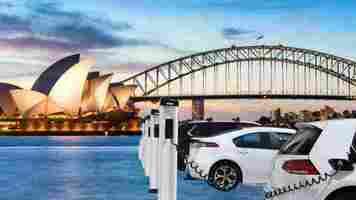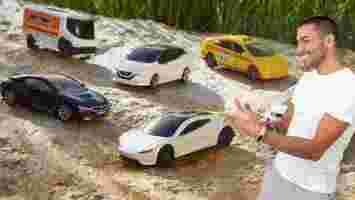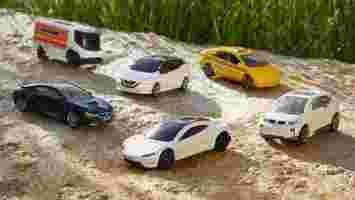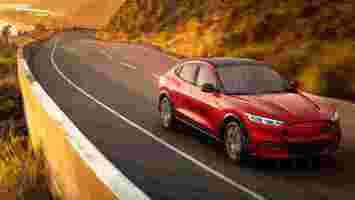Australian state spends $375M on EV boost to become the Norway down under
A month ago, New South Wales (NSW) Transport Minister Andrew Constance had criticized Australia’s slow transition to EVs , emphasizing the need for bigger incentives.

Well, that’s old news! Two days ago, the NSW government announced an a mbitious $375 million plan for battery-powered cars, the Sydney Morning Herald reports. The government hopes that with this plan EVs will make up more than half of new car sales by 2030.
Specifically, s tamp duty will be removed from EVs that cost less than $58,580 by September this year, and a $2,253 rebate will be given to the first 25,000 vehicles sold in New South Wales for under $51,069.
But there’s a catch. T his extra support will be counterbalanced by a road-user charge of $1.9 cents per kilometer by 2027, or once electric vehicles make up 30% of new car sales.
The same road-user charge has been introduced in Victoria and will start the first of July, a fact that was heavily criticized by Constance.
The minister had commented that the Victorian’s state tax on electric vehicles is happening “too soon,” and that the NSW government would not apply such a levy until EVs make up 40 to 50% of the car market – which now dropped to 30%.
Notably, compared to Victoria, NSW state’s budget is fiver times larger, and the government also plans to invest $128 million on highway charging infrastructure. What’s more, new regulations will allow EVs to use transit lanes and priority parking spots to recharge.
“We’re charging up the nation to make NSW the Norway of Australia when it comes to electric vehicles,” Environment Minister Matt Kean said, referring to Europe’s largest EV market.
This sounds somewhat overconfident, coming from a state that is only now embarking on the EV switch, but NSW’s plan is indeed the most “aggressive” yet in Australia. With EVs currently making up less than 1% of new car sales in New South Wales, the government’s Electric Vehicle Strategy pack can only be a good thing.
Do EVs excite your electrons? Do ebikes get your wheels spinning? Do self-driving cars get you all charged up?
Then you need the weekly SHIFT newsletter in your life. Click here to sign up
Even toy car maker Matchbox is jumping on the EV trend
For a lot of car nerds, the passion began before they could even drive, with toy cars like the diecast scale models made by Matchbox.

Matchbox might be single-handedly responsible for getting more kids into cars than anyone, or anything, else. That company is the reason I smile every time I see an E31 era BMW 8 Series.
Now, in keeping with the times, Matchbox is releasing a bunch of new models of electric vehicles, including the Tesla Roadster, Nissan Leaf, BMW i3, i8, and an e-Star delivery van.


While making models of EVs will surely get youngsters interested in the electric revolution, Matchbox is also taking on some responsibility itself.
The new electrically inspired models will be made from recycled materials, and so will the packaging! The company has committed, like many real EV makers, to being more responsible with how it makes its cars.
By 2030, the company has pledged to make all of its cars, playsets, and packaging with 100% recycled materials.
“Since the inception of the modern-day diecast car nearly 70 years ago, Matchbox has been using design and innovation to connect kids with the real world around them through play,” said Roberto Stanichi, global head of vehicles at Mattel, Matchbox’s parent company.
The Matchbox Tesla Roadster will be made from 99% recycled materials and will be available from 2022.
At this rate, we might actually get the Matchbox Roadster before Tesla comes out with the real one .
Do EVs excite your electrons? Do ebikes get your wheels spinning? Do self-driving cars get you all charged up?
Then you need the weekly SHIFT newsletter in your life. Click here to sign up .
How the US is setting itself up for a future of electric vehicles
This article was originally published by Steve Schaefer on Clean Fleet Report , a publication that gives its readers the information they need to move to cars and trucks with best fuel economy, including electric cars, fuel cells, plug-in hybrids, hybrids and advanced diesel and gasoline engines.

It was a week of good news for EVs and climate action, as General Motors and the new U.S. president announced ambitious plans to tackle global warming. Both set a goal fourteen years out, which, although it’s later than the often-cited 2030 target from the Paris Agreement, is a profound move forward.
General Motors makes a commitment
Years ago, Charles Wilson, President of General Motors, and Eisenhower’s nominee for Secretary of Defense, famously said, “What is good for the country is good for General Motors and vice versa.” Democrats on the committee focused on the vice versa of the statement, but in the modern case, it may actually be true either way.
When GM first stated its intention to move toward electric vehicles and rolled out its vision of Zero Crashes, Zero Emissions, and Zero Congestion, I was skeptical. After all, this is the company that makes its money on gas-guzzling pickup trucks and Chevy Tahoes and has promoted Corvettes and Camaros. But they did introduce the worthy Bolt EV and were dabbling in green tech with the plug-in hybrid Volt before that.
With Tesla in their rearview mirror (or maybe now seen through their windshield!), one of America’s “big three” has officially put their bets on electric cars and has announced their plan to have a 100% electric fleet by 2035. GM will introduce 30 new EVs by 2025, including a new all-electric Hummer! They are developing a new flexible platform and the Ultium battery, which they will produce themselves. And they are putting $27 billion on the table to do it. With their long-established cross-country dealer network and factories in America, they have a good start.
Last night, I watched a recording of GM President Mark Reuss talking with Malcolm Gladwell at CES 2021 for GM Exhibit Zero . He said all the right things and laid out GM’s plan for 30 EVs by 2025 and all the rest. GM CEO Mary Barra has been quite forthright about the company’s plans, too.
Biden steps forward on climate change action
Meanwhile, America’s new president put forward his plan, and it’s just what many of us have been waiting for. Immediately putting the U.S. back in the Paris Agreement and canceling the Keystone XL Pipeline were signature acts, but Biden’s announcement of moving to an all-electric fleet was an eye-opener . It goes along with California’s 2035 target of no new light-duty internal combustion engine vehicles sold starting in 2035. The Golden State has been leading the charge towards lower emissions for decades. It also fits nicely into GM’s plan.
Ford is planning and releasing EVs, too
Ford is investing more than $11.5 billion in electric vehicles through 2022, and zero-emission versions of some of its most popular nameplates are on the way, including the Mustang Mach-E, which starts arriving in dealerships this year, as well as a Transit Commercial EV and fully electric F-150 coming within 24 months.
The company previously announced its plan to use 100% locally sourced renewable energy for all its manufacturing plants globally by 2035. That means energy would come only from sources that naturally replenish – such as hydropower, geothermal, wind, or solar.
However, as builders of America’s favorite vehicle for more than four decades, the F-150 pickup, they can have a big impact by putting an electric motor under its tall hood. And, leveraging the reputation of their most iconic vehicle, the Mustang, they have just introduced the category-bending, all-new Mustang Mach-E, an all-electric four-door crossover that has the Tesla Model Y in its sights (with a heavy dash of Mustang traditional styling and performance). If these two pillars of Ford’s product line move the sales needle, Ford will be making an impact, too, and can start introducing more electrified vehicles.
It’s easy to see America’s two surviving American-owned car companies jumping in and writing big orders for all those electrified U.S. government fleet vehicles and making those American factories hum with green-tech jobs. It has win-win written all over it. Of course, making this huge transition will not be easy or instant, but the overwhelming weight of scientific evidence tells us we must do it now.
When Mark Reuss answered Malcolm Gladwell’s question, “Why now?” during the interview, he said it was because it was the right thing to doand that he wanted a safe, healthy world for his three grandchildren. As a grandparent myself, I wholeheartedly agree.
Bold initiatives by corporations, states, and national governments have proven effective in Europe and China, and now the U.S., under new leadership and in cooperation with its auto manufacturers, is approaching the EV tipping point. I have more faith now that we can and will make this happen. In the middle of the next decade, it will all seem like it was meant to be, and once-skeptical buyers will be sold on the new, cleaner, better technology. For now, I’m doing whatever I can to push us to and beyond the EV tipping point.
You can follow Clean Fleet Report on Twitter and Facebook .
Credit: Clean Fleet
SHIFT is brought to you by Polestar. It’s time to accelerate the shift to sustainable mobility. That is why Polestar combines electric driving with cutting-edge design and thrilling performance. Find out how .